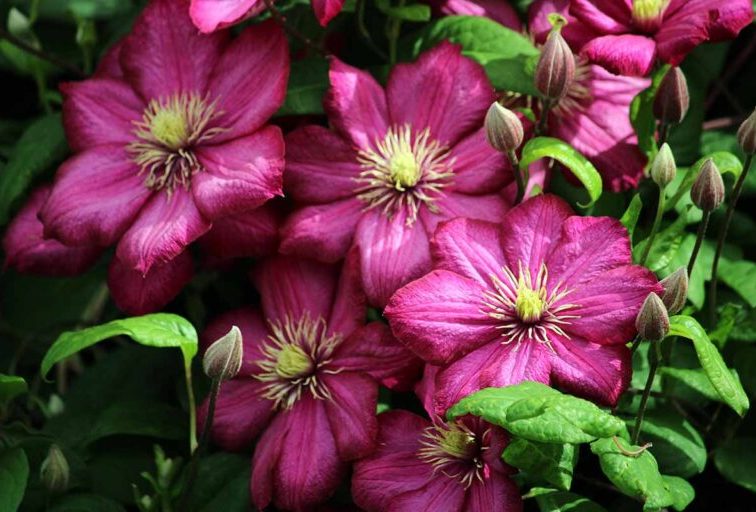Contents
Intro
How long do clematis bloom? Well, if you’re diving into the world of gardening, specifically with this beautiful flowering plant, you’ll find some pretty fascinating aspects! Clematis is not just any ordinary vine in your garden; it has a character of its own. Trust me, as someone who’s explored gardening extensively, understanding your clematis is part of the fun and crucial for a thriving garden. So let’s get into it! We will explore how to grow clematis, its blooming seasons, and how to care for them like a pro.
Growing Clematis

Types of Clematis
Clematis comes in many varieties, making it one of the most diverse flowering plants out there. From striking purples to soft pinks, there’s a clematis for every taste. Some varieties are more disease resistant, while others can flourish even in challenging climates. Choosing the right type of clematis can set you up for success. I love experimenting with different ones! For example, the Jackmanii variety blooms vigorously, while Nelly Moser has those stunning, large flowers that always catch my eye.
Ideal Growing Conditions
Now let’s talk real estate. Clematis thrives in spots that get a good amount of sunlight – I’m talking at least six hours a day. If you’re wondering where to plant, consider walls or fences, as they provide the perfect climbing structure. Clever, right? The soil is equally vital. Well-drained soil keeps your clematis healthy—nobody wants waterlogged roots!
A pro tip? Check your soil health. I mix in compost to enhance drainage and nutrients. The better the conditions, the more vibrant your clematis will be!
Watering Needs
Watering is kind of like the cherry on top when it comes to clematis care. Regular watering is a must, especially during dry spells. Like, nobody wants a wilted plant staring back at them! However, don’t go overboard; avoid waterlogging. A good rule of thumb is to feel the soil with your fingers. If it feels dry about an inch down, it’s watering time!
Blooming Seasons

Classification of Blooming Groups
So, how long do clematis bloom? The answer can vary based on their group classification. Here’s the breakdown:
1. Group 1: These are your early bloomers, flowering in spring on last year’s growth. You just need to prune lightly after they bloom.
2. Group 2: This is the best of both worlds! They bloom in early summer on old growth and give you a second round of blooms later on new growth. Prune after the first bloom.
3. Group 3: Now we’re talking about the late bloomers! These guys flower late in summer and fall on new growth. Make sure to prune them back in late winter to early spring to encourage that vigorous new growth.
Knowing this helps you schedule your gardening and enjoy those blooms longer!
Pruning Techniques
Now, let’s discuss the often intimidating topic of pruning. For Group 1, I usually just give them a light trim after they’re done blooming. For the re-bloomers in Group 2, I prune them lightly after the first bloom—I want to keep that cycle going! Then for Group 3, I get a bit more serious; I do my cuts in late winter to late spring to set them up for success.
When you prune right, you’re like a cheerleader for your clematis; you encourage healthy growth, making your plants bloom even better the following seasons.
Caring for Clematis

Pruning for Health and Blooming
Pruning isn’t just a chore; it’s essential for healthy growth. Regular pruning tailored to the group makes a world of difference in the number and quality of blooms you’ll get. So, let’s say I notice my Group 1 clematis isn’t blooming as much; a quick pruning session does wonders!
Fertilization Practices
Next up, fertilization. I opt for a low-phosphorous fertilizer to avoid any serious root damage. It’s like feeding your clematis the right diet to prevent issues! I like to fertilize about once in the early spring and then again in midsummer. Watching my clematis thrive gives me all the gardening feels!
Common Problems
Pests
Now, let’s be real about pests. Clematis can attract several unpleasant visitors like aphids. I learned quickly to keep an eye out! If you notice any unwelcome guests munching on your plant, it’s time to act. I usually spray them off with a powerful blast of water or use insecticidal soap as a backup.
Diseases
Don’t forget about diseases, either. Wilt is a common issue with clematis, especially when they’re stressed. It’s a bit of a bummer, but being vigilant about their health can prevent this from happening. Keeping them in well-drained soil and the right light conditions can minimize these problems!
Preventive Measures
Regular inspections of your plants can help you catch any issues before they escalate. I stroll through my garden regularly—consider it a mandatory checkup for my precious plants.
Conclusion
Whether you’re a gardening newbie or a seasoned expert, clematis can bring unmatched beauty to your garden. Have questions, tips, or stories to share? Drop a comment, share with your friends, or dive into more on our site at Starter Vegetable Gardens. Happy gardening!


